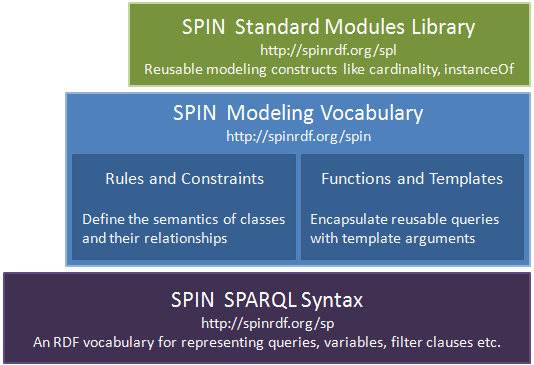-- 发布时间:4/7/2009 2:10:00 PM
-- 技术介绍:SPIN - SPARQL Inferencing Notation
SPIN - SPARQL Inferencing Notation
December 31, 2008
Authors:
Holger Knublauch <[URL=mailto:holger@topquadrant.com]holger@topquadrant.com[/URL]>
Overview
SPIN is a collection of RDF vocabularies enabling the use of SPARQL to define constraints and inference rules on Semantic Web models. SPIN also provides meta-modeling capabilities that allow users to define their own SPARQL functions and query templates. Finally, SPIN includes a ready to use library of common functions.
SPIN has been designed by TopQuadrant to solve real-world customer needs such as:
* Calculate the value of a property based on other properties - for example, area of a geometric figure as a product of its height and width, age of a person as a difference between today's date and person's birthday, a display name as a concatenation of the first and last names
* Constraint checking with closed world semantics - for example, a need to automatically raise inconsistency flags when currently available information does not fit the specified integrity constraints
* Isolate a set of rules to be executed under certain conditions - for example, to support incremental reasoning, to initialize certain values when a resource is first created, or to drive interactive applications
SPARQL's unique strengths make it an excellent fit for addressing these needs. SPARQL is a well-established W3C standard implemented by many industrial-strength RDF APIs and databases. SPIN provides a framework that helps users to leverage the fast performance and rich expressivity of SPARQL for various application purposes.
Instead of relying on the textual representation of SPARQL expressions, SPIN offers an RDF Schema for SPARQL. As a result, SPARQL queries can be stored as RDF triples together with any RDF domain model. This enables linkage of RDF resources with the associated SPARQL queries as well as sharing and reuse of SPARQL queries as part of Semantic Web models. An RDF vocabulary for SPARQL is the first layer in the SPIN framework.
Using the SPARQL RDF syntax, SPIN defines a light-weight collection of RDF properties that allow domain modelers to attach inference rules (as SPARQL Construct queries) and constraint checks/unit tests (as Construct or Ask queries) to RDFS or OWL class definitions:
* SPIN inference rules can then be used to derive new RDF statements from existing RDF statements at the instances of those classes.
* There is a special kind of inference rules, called constructors which can be used to initialize resources with default values at creation time.
* SPIN constraints can be used to specify conditions that all members of classes must fulfill.
Properties for attaching rules and constraints to classes are provided by the SPIN Vocabulary, a second layer in the SPIN framework. Note that by providing a way to attach rules and constraints to classes, SPIN supports an object-oriented modeling paradigm that is familiar to many potential users. However, in contrast to classical object-oriented systems, SPIN is fully embedded into the Semantic Web space, making it possible to link web resources together to integrate data from various sources. Also, although SPIN can be used to encapsulate behavior with objects, this happens purely declaratively and thus transparent to humans or agents.
SPIN also offers a very powerful meta-modeling mechanism that can be employed to define new SPARQL functions based on other SPARQL expressions, and to encapsulate reusable SPARQL query templates. The SPIN templates mechanism makes it possible to define domain-specific modeling languages with executable, declarative semantics. Based on this mechanism, SPIN provides a library of frequently needed modeling patterns with functions and templates to constrain cardinalities and value ranges. This module library is the third layer in the SPIN framework.
1.0.0 beta
Specifications
* [URL=http://spinrdf.org/sp.html]The SPIN SPARQL Syntax[/URL]
* [URL=http://spinrdf.org/spin.html]The SPIN Modeling Vocabulary[/URL]
* [URL=http://spinrdf.org/spl.html]The SPIN Standard Modules Library[/URL]
Implementations
* [URL=http://sparqlpedia.org/spinrdfconverter.html]Online SPIN RDF Converter[/URL]
* [URL=http://www.topquadrant.com/topbraid/composer/spin.html]TopBraid Composer (Editor)[/URL]
* [URL=http://topbraid.org/spin/api]TopBraid SPIN API (Open Source)[/URL]
Example Applications using SPIN
* [URL=http://composing-the-semantic-web.blogspot.com/2009/01/video-sparql-based-unit-conversion-with.html]SPARQL-based Unit Conversion with SPIN (with Video)[/URL]
* [URL=http://composing-the-semantic-web.blogspot.com/2009/01/video-sparql-based-inferencing-and.html]Inferencing and Constraint Checking (with Video)[/URL]
* [URL=http://composing-the-semantic-web.blogspot.com/2009/01/owl-2-rl-in-sparql-using-spin.html]OWL 2 RL in SPARQL using SPIN[/URL]
* [URL=http://composing-the-semantic-web.blogspot.com/2009/01/spin-box-sparql-based-computer-game.html]SPIN Box: A SPARQL-based Computer Game Engine (with Video)[/URL]
Articles
* [URL=http://stage.vambenepe.com/archives/496]A new SPIN on enriching a model with domain knowledge (constraints and inferences)[/URL]
* [URL=http://composing-the-semantic-web.blogspot.com/2009/01/object-oriented-semantic-web-with-spin.html]The Object-Oriented Semantic Web with SPIN[/URL]
* [URL=http://composing-the-semantic-web.blogspot.com/2009/01/understanding-spin-functions.html]Understanding SPIN Functions[/URL]
* [URL=http://composing-the-semantic-web.blogspot.com/2009/01/understanding-spin-templates.html]Understanding SPIN Templates[/URL]
